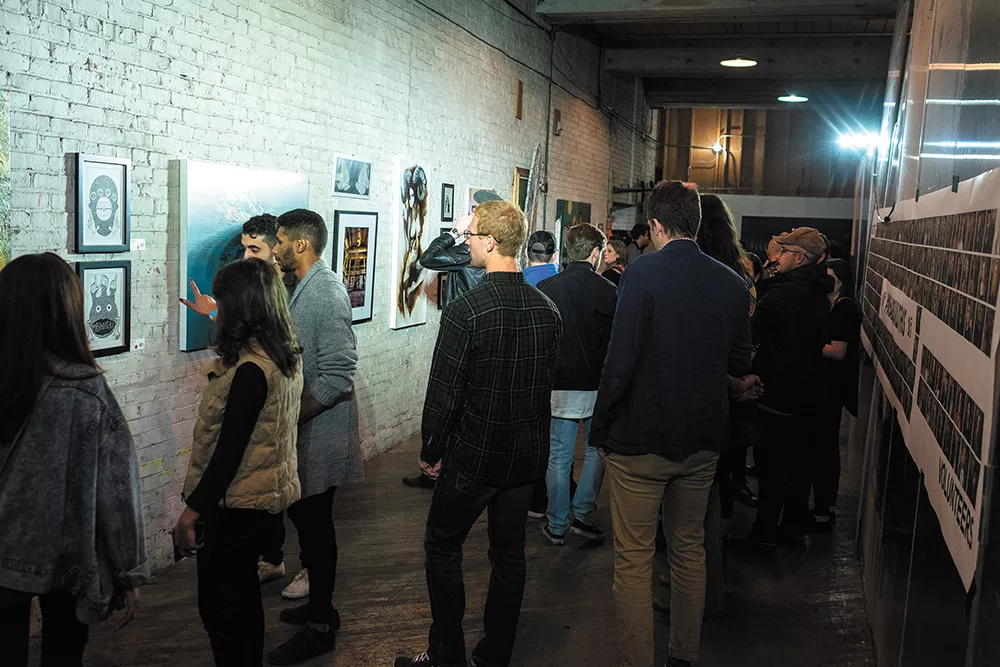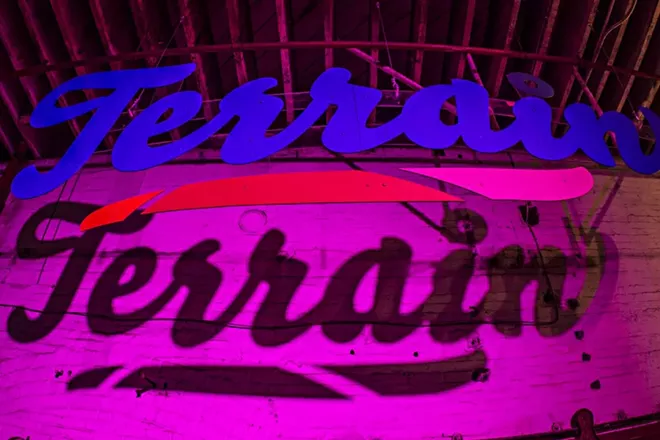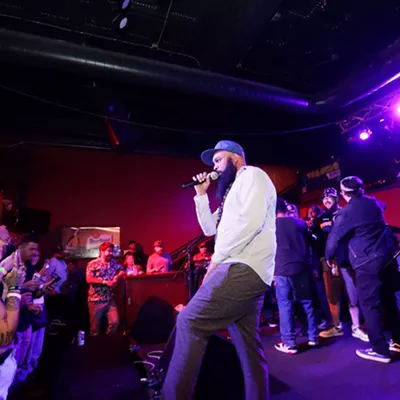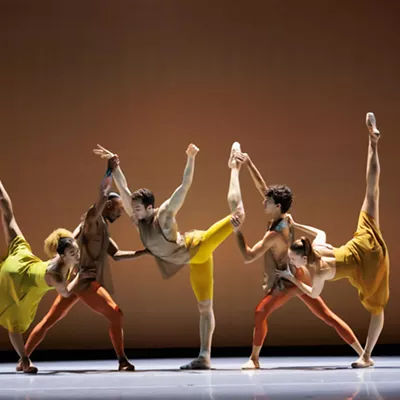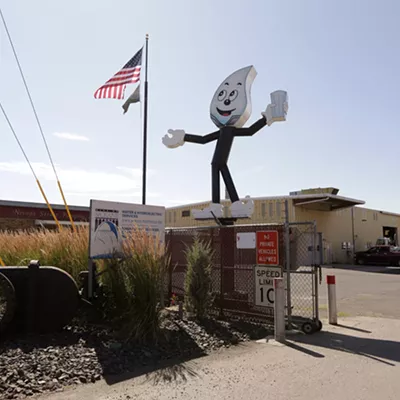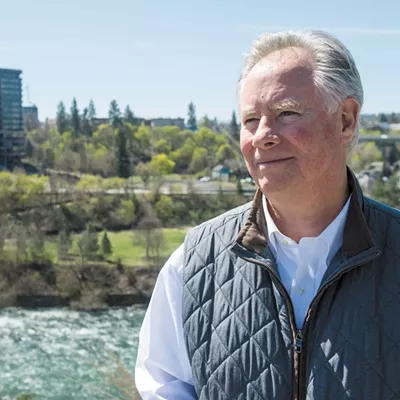When Spokane invested nearly a half million dollars to sell the city to the west side of Washington, it touted one local arts group in particular.
"As Terrain has grown from a one-off art party to a cultural juggernaut with a permanent art gallery, performing art space, and year-round programming, the organization has focused on responding to community needs by building connections," the article on the city's #HackingWashington website explains.
Indeed, the article itself is evidence of the deep connections Terrain has built over the past decade. The marketing firm behind it, Treatment, is owned by Luke Baumgarten, one of Terrain's co-founders. He edited the particular article that relies heavily on quotes from himself and his wife, Ginger Ewing, Terrain's executive director, and it features a photo of them.
It's no small thing that Terrain — once a tiny group of 20-somethings putting on giant parties in vacant warehouses — now has a hand in shaping the city's own story. And while Terrain doesn't necessarily have the largest staff or the biggest budget of local arts groups, it may have become the most influential.
As when anything gets big, people don't always appreciate the shadows it casts.
"When we grow to the size we are, there's always going to be criticism," Ewing says, adding that she encourages people with complaints about Terrain's role to meet with her personally.
The vast majority of the artists and organizers the Inlander spoke with had effusive praise for what Terrain has accomplished — believing that Terrain's rising tide has lifted all the other boats in the arts community — but others expressed wariness about talking fully, concerned there would be backlash if they criticized such a popular and powerful local nonprofit.
At times, the criticism has come from inside the organization. Former board members like Brian Estes and Diego Sanchez both critique Terrain for what they see as missed opportunities to shine the spotlight on other artists. In particular, Sanchez argues, the organization should be faceless, focused not on Baumgarten or Ewing, but on the artists.
Where are the young artists, he asks, chomping at the bit to get involved with Terrain?
"If Luke or Ginger leaves, what is Terrain?" Sanchez says. "That's how it's set up now. It's their organization, not an organization of artists."
To be sure, as Terrain moves into its second decade, it faces a particular challenge: How do you increase the size of your footprint without stepping on toes? When your mantra is "We All Build This," how do you build up the whole arts community while growing yourself?
CONNECTIONS
From early on, Terrain was helped out through its city connections. When the group failed to get its special occasion permit in on time, Mayor Mary Verner's office wrote a "letter of no objection" to speed up the process. Mayor David Condon's administration created new policies to allow Terrain to have an outdoor beer garden for its "Bazaar" arts marketplace in 2014.
"I think some of the arts community
relies too much on Terrain
to provide it all for them."
~ Jenny Hyde, EWU digital arts professor
And when fire marshals cracked down on the capacity of the big Terrain event at the Music City Building one year, Council President Ben Stuckart and Washington state Sen. Andy Billig volunteered to stand outside and count attendees. Stuckart, in fact, was on the city committee championing Treatment's bid to receive $84,000 in public funds for the #HackingWashington marketing efforts. Simultaneously, he was serving on the Terrain board with Baumgarten.
relies too much on Terrain
to provide it all for them."
The assistance went both ways: Baumgarten and several other artists hosted a Terrain preview night that doubled as an "Arts Month Celebration of Ben Stuckart" fundraiser during Stuckart's 2015 run for city council president.
Just this April, Condon awarded Terrain $10,000 to support a youth arts program as part of the Mayor's Youth Initiative.
Terrain has media expertise as well: Baumgarten used to be the culture editor of the Inlander. And Terrain's annual arts showcase is precisely the sort of big extravaganza that grabs newspaper headlines, sometimes at the expense of other events.
"I think many art venues, artists and other organizations get overlooked by the media," says Jenny Hyde, who teaches digital arts at Eastern Washington University. To the public, she says, it can seem like Terrain is the only visual art event in this town.
"'Terrain sucks all the air out of the room' is one criticism we've heard," Baumgarten says.
A few years ago, he says, Spokane Arts, the nonprofit behind the Fall Visual Arts Tour, asked whether Terrain should change weekends, because it was drowning out everyone else. Terrain ultimately declined.
By the time Laura Becker beat out Baumgarten to be the director of Spokane Arts in 2014, Terrain had become a force to be reckoned with.
"There were moments where I felt intimidated, because they knew everyone in town... They had personal relationships with people. They were on a first-name basis with fundraisers on boards," Becker says. "I didn't necessarily have that social capital. I had to build it."
By the time Becker left Spokane Arts in 2016, she says she figured out that Terrain and Spokane Arts had two distinct roles. They weren't in competition with each other.
Still, Becker worries that the success of Terrain may scare away artists from taking chances: Why compete for grants or sponsorships, she says people may think, when you're trying to compete with Terrain?
"It's really hard for individual artists or nascent organizations to get support," Becker says.
After all, there's a finite pool of funding in the community. It's not that Terrain is flush with revenue — far from it. But Terrain has expertise.
"Every grant is a competition," says grant consultant Katie Howard, a former Terrain board member. "There's always limited funds to go around."
In one case, Howard says, she declined a request for assistance from another similar arts organization because she was simultaneously working on a similar grant proposal for Terrain.
"I encouraged the two organizations to explore collaboration," Howard says.
In fact, one major victory for the arts community came when Stuckart, Terrain and Becker teamed up to push for a single goal: The creation of the city-funded Spokane Arts Grant Awards in 2016, to be distributed by Spokane Arts. Yes, Terrain walked away with one of Spokane Arts' first funding grants last year. But dozens of other arts projects, across wide disciplines, have also been funded since.
It's alleviated some of the tension: Everyone's still competing for slices of the pie — but the pie is now bigger.
REJECTIONS
Local painter Audreana Camm didn't get accepted into this year's Terrain event on Oct. 4-5. Well, at least her art didn't. And there were plenty of insults added to the injury: A photographer took some pictures of her — and those are getting into Terrain. Not only that, but Camm and several other rejected artists said they received multiple rounds of rejection emails.
All these years, she says, and she's only been in Terrain once. And that piece — "a weird piece about bread clips" — wasn't even her art style.
She even considered a bit of a guerilla protest with some of her artist friends. They'd bring their art to Terrain anyway — wear it, strap it to their bodies, and simply walk around the show like they're supposed to be there.
For some artists, like former Gonzaga lecturer Austin Stiegemeier, getting a slate of pieces into Terrain represented their big break. But for those denied, it's more like heartbreak.
There are common complaints shared by those rejected from Terrain. It's biased. It's elitist. It's all about who you know. It's a "cool kids club." It's a clique.
Some of those frustrations may be based on misconceptions of how the jury works. Early on, Terrain co-founder Patrick Kendrick says, Terrain handed off its art selection process to an independent jury, realizing they were too embedded in the community to decide on it themselves.
"We know too many artists," Kendrick says.
So Terrain handed off its art selection process to an independent jury. That jury changes over every year, with an eye toward diversity of all sorts, including age, artistic mediums and cultural backgrounds.
"We don't want to have an 'aesthetic,'" Baumgarten says. Still, as Terrain has gone from 70 submissions to over 2,000, a lot of pieces are going to get rejected.
Even with the changes to the jurying process, Kendrick says he continued to hear the complaints about "elitist-ass Terrain" not appreciating the work of some local artists.
"Part of me was like: 'Do your own thing,'" Kendrick says.
Some artists have. Local artist LauraLee White says she and a buddy started their own art and music collective, "La Resistance," when they kept getting denied from Terrain.
"We felt it was local politics or something," White says. "It's not like we were egotistical, but our art isn't crap."
Other entities, like the grassroots curating group Art Seed, have risen up as a kind of alternative to Terrain as well.
But to Kendrick, that's a victory. His vision for Terrain wasn't about a single organization growing massive — he had originally hoped it would "just be this cool underground anonymous entity" — but about inspiring a wave of similar events across the community.
One repeated refrain by members of the local arts scene isn't that they want Terrain to do more or do less, it's that they want to see other arts organizations rise up, too.
"I think some of the arts community relies too much on Terrain to provide it all for them," says Hyde, the Eastern Washington University professor.
It's why Terrain focuses so much on partnerships with organizations like the interactive-art residency program Laboratory, which excels in areas Terrain isn't currently in. That's some of the thinking behind Terrain's Creative Enterprise program: Essentially, it's an artistic bootcamp, training creative types in developing business plans and marketing strategies. It's a way of giving artists tools to create future Terrains.
Even as Terrain looks to expand further, the risk of burnout remains real, say supporters. Terrain still only has two full-time paid staff members (Ewing and operations director Jackie Caro), and Terrain's scope keeps increasing.
As she sits for an interview with the Inlander — grappling with criticism, preparing for the Terrain's 11th signature event next week — Ewing's eyes well up and tears begin to stream down her cheeks.
"I don't want to sound like a martyr, but I have literally had the thought, 'Am I going to die at age 45?'" Ewing says. "We work our f—-ing asses off, you know."♦

